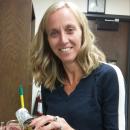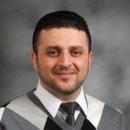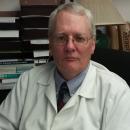M.S. in Microbiology, Arizona State University
B.A. in Biology and Spanish, Knox College
Kip came to NEIU after working in biocides research and development at Dow Chemical, and later as a research geneticist testing new drugs for toxicity in mammalian immune cell lines. At Arizona State University he enjoyed a National Science Foundation Fellowship where he was able to present his virology research to high school students to inspire a new generation of scientists. His master’s degree resulted in a publication as well as a patented method to facilitate genetic engineering in viruses. His interest in sharing his love for microbiology compelled him to seek employment in a university setting.
BBH 358E
Northeastern Illinois University
5500 North St. Louis Avenue
Chicago, IL 60625
United States

Keywords: Neurobiology, vision, assistive technology, blind/visually impaired, haptics
Ph.D. in Biological Psychology from The University of Chicago
B.A. in Psychology from the University of Illinois at Chicago
Undergraduate students are underlined
Prete FR, Schirmer AE, Patel S, Carrion C, Prete GM, van Alphen B, Svenson GJ (2019). The first analysis of discontinuous ventilatory abdominal pulsations in praying mantises. Fragmenta Entomologica, 51: 29-39 https://rosa.uniroma1.it/
Schirmer A, Prete FR, Mantes ES, Urdiales AF, Bogue W (2014) Circadian rhythms affect electroretinogram, compound eye color, striking behavior and locomotion of the praying mantis Hierodula patellifera. Journal Experimental Biology, 217: 3853-3861 https://pubmed.ncbi.nlm.nih.
Prete FR, R Theis, Dominguez S, Bogue W (2013) Visual Stimuli Eliciting Tracking and Striking in the Praying Mantises, Parasphendale affinis (Giglio-Tos), Popa spurca (Stål), and Sphodromantis lineola (Burmeister). Journal of Experimental Biology, 216: 4443-53
Popkiewicz B, FR Prete (2013) Macroscopic Characteristics of the Praying Mantis Electroretinogram, Journal of Insect Physiology, 59: 812–823
Prete FR, Dominguez S, Komito JL, Theis R, Dominguez JM, Hurd LE, Svenson GJ, (2013) Appetitive Responses to Computer-Generated Visual Stimuli by Female Rhombodera basalis, Deroplatys lobata, Hierodula membranacea, and Miomantis sp. (Insecta: Mantodea), Journal of Insect Behavior, 26: 261-282. https://link.springer.com/
Room BBH 344F
Northeastern Illinois University
5500 North St. Louis Avenue
Chicago, IL 60625
United States
Ph.D., Northwestern University
Room BBH 217A
Northeastern Illinois University
5500 North St. Louis Avenue
Chicago, IL 60625
United States
Keywords: Pedagogy, scientific identity, learning support, learning
Ph.D. in Evolutionary Biology from University of Chicago
B.S. in Biology from University of Iowa
Nuss K, Warneke M. Life span, reproductive output, and reproductive opportunity in captive Goeldi's monkeys (Callimico goeldii). Zoo Biol. 2010 Jan-Feb;29(1):1-15. PubMed PMID: 20131357.
Room BBH 217A
Northeastern Illinois University
5500 North St. Louis Avenue
Chicago, IL 60625
United States

Ph.D. in Molecular Biology from Loyola University Chicago (Stritch School of Medicine) and University of Chicago
B.S. in Biology from Boston College
Spear TT, Riley TP, Lyons GE, Callender GG, Roszkowski JJ, Wang Y, Simms PE, Scurti GM, Foley KC, Murray DC, Hellman LM, McMahan RH, Iwashima M, Garrett-Mayer E, Rosen HR, Baker BM, Nishimura MI. Hepatitis C virus-cross-reactive TCR gene-modified T cells: a model for immunotherapy against diseases with genomic instability.J Leukoc Biol. 2016 Sep;100(3):545-57.
Zloza A, Lyons GE, Schenkel JM, Moore TV, Lacek AT, O’Sullivan JA, Varanasi V, et al. NKGD2 signalling on CD8+ T cells represses T-bet and rescues CD4- unhelped CD8 + T cell memory recall but not effector responses. Nature Medicine. 2012 Feb 26; 18(3):422-8.
Zloza A, Lyons GE, Chlewicki LK, Kohlhapp FJ, O'Sullivan JA, Lacek AT, Moore TV, Jagoda MC, Kumar V, Guevara-Patiño JA. Engagement of NK receptor NKG2D, but not 2B4, results in self reactive CD8+ T cells and autoimmune vitiligo. Autoimmunity. 2011 Dec; 44(8):599-606.
Zloza A, Jagoda MC, Lyons GE, Graves MC, Kohlhapp FJ, O'Sullivan JA, Lacek AT, Nishimura MI, Guevara-Patiño JA. CD8 co-receptor promotes susceptibility of CD8+ T cells to transforming growth factor-β (TGF-β)-mediated suppression. Cancer Immunol Immunother. 2011 Feb; 60(2):291-7.
Lyons, GE, McCracken J, O’Sullivan J, Guevara-Patino J. RAE1-e Signaling Rescues “Helpless” CD8+ T cell Memory Responses. Journal of Exp. Medicine. January, 2011.
Room BBH 352G
Northeastern Illinois University
5500 North St. Louis Avenue
Chicago, IL 60625
United States

Keywords: hyperglycemia, Methylglyoxal, oxidative stressors, glutathione
M.S. in Molecular Biology from Northeastern Illinois University
M.S. in Veterinary Microbiology and Immunology from the College of Veterinary Medicine, Iraq
B.V.M.&S. (Bachelor of Veterinary Medicine and Surgery) from the College of Veterinary Medicine, Iraq
Gorgis, T., Habib, N. and Mungre, S. (2010), Effect of Methylglyoxal on BV-2 Cells. FASEB J, 24: lb132-lb132. https://doi.org/
Habib, N. and Mungre, S. (2010), Oxidative Stress Injury To PC12 Cells Under Glycating Conditions. FASEB J, 24: 485.7-485.7. https://doi.org/
Habib, N., Goswami, G. and Mungre, S. (2010), Inflammatory Cytokines Induce Oxidative Stress And Apoptosis In PC12 Cells. FASEB J, 24: 485.8-485.8. https://doi.org/
Room BBH 358C
Northeastern Illinois University
5500 North St. Louis Avenue
Chicago, IL 60625
United States

Keywords: gerontology, life-history, aging, Paramecium, antioxidants
Ph.D. in Zoology and Physiology from the University of Wyoming
M.D. from the Howard University College of Medicine
M.S. in Biological Sciences from the University of Illinois
B.S. in Biology from Western Michigan University
Room BBH 340G
Northeastern Illinois University
5500 North Saint Louis Avenue
Chicago, IL 60625
United States

St. Olaf College, Chemistry, B.A. magna cum laude, 1996-2000
Honors Thesis: “Monitoring phospholipase A2 (PLA2) activity by reversed-phase, high-pressure liquid chromatography (RP-HPLC).”
The University of Chicago, Biochemistry and Molecular Biology, Ph.D. 2000-2005
Ph.D. Dissertation: “Characterization of the coliphage N4-encoded N-acetylmuramidase, a member of a new family of peptidoglycan-hydrolyzing enzymes.”
2013 Fixen, K.R., A.W. Baker^, E. A. Stojković, J. T. Beatty and C.S. Hardwood. Chromophore-independent modulation of photosynthesis by bacteriophytochromes in response to low light. Proc Natl Acad Sci USA 111 (2): E237-44.
2013 Neider, J., E. A. Stojković, K. Moffat, K. Forest, T. Lamparter, R. Bittl and J.T.M. Kennis. (2013) Pigment-Protein Interactions in Phytochromes Probed by Fluorescence Line Narrowing Spectroscopy. J Phys Chem B 117(48):14940-50
2012 F. G. Tobias^, A. Gawedzka^, M. S. Goldmeier^, A. C. Sakols^, E. A. Stojković, S. Tsonchev, and K.T. Nicholson, “Scanning Probe Microscopy of Bacterial Red-Light Photoreceptors”, MRS Proceedings, 1465, mrss12-1465-ss07-12.
2011 Woitowich, N.C., S. E. Kovaleva^, W. Ozarowski and E. A. Stojković. Preliminary X-ray crystallographic and structural analyses of a bacteriophytochrome from Stigmatella aurantiaca. FASEB J. 25:928.15
2011 Toh, K.C., E. A. Stojković, I. H. van Stokkum, K. Moffat and J.T.M. Kennis. Fluorescence quantum yield and photochemistry of bacteriophytochrome constructs. Phys Chem Chem Phys 13 (25): 11985-97.
2011 Toh, K.C., E. A. Stojković, A. Rupenyan, I.H.M. van Stokkum, M. Salumbides, M. Groot, K. Moffat and J. T.M. Kennis. Primary reactions of bacteriophytochrome observed with ultrafast mid-infrared spectroscopy. J Phys Chem A 115 (16): 3778-86.
2010 Toh, K.C., E. A. Stojković, I.H.M. van Stokkum, K. Moffat and J. T.M. Kennis. Proton transfer and hydrogen bond interactions determine fluorescence quantum yield and photochemical efficiency of bacteriophytochrome. Proc Natl Acad Sci USA 107 (20): 9170-9175.
BBH 352H
Northeastern Illinois University
5500 North Saint Louis Avenue
Chicago, IL 60625
United States

Ph.D., Environmental Biology, University of Louisville
B.S., Biology, University of Notre Dame
Slate, J. E., Adler, R. F., Hibdon Jr., J. E., Mayle, S. T., Kim, H., and Srinivas, S. 2019. A multidisciplinary approach to incorporating computational thinking in STEM courses for preservice teachers. In (R. M. Reardon & J. Leonard, eds) Integrating Digital Technology in Education, Information Age Publishing Inc.: Charlotte, N.C.
SCIENTIFIC MODELING IN EDUCATION:
Introductory biology students seldom have the opportunity to build or modify scientific models, despite their importance in bioscience research. Thus, I am developing educational activities for beginning students who are new to modeling. With support from a STEM+C grant from the National Science Foundation, I worked with a group of biology, computer science, math, and education students to create a simulation that applies the Susceptible-Infected-Recovered (SIR) model, commonly utilized by public health officials to predict the spread of disease, to simulate a mosquito-borne viral outbreak. In addition to using the simulation to test disease-causing scenarios, students can expand upon the model by writing computer code. It is thus an excellent exercise to show beginning biology students how computer modeling and simulation is used to examine biological systems.
BIOLOGICAL INDICATORS OF WATER QUALITY:
As sessile aquatic invertebrates, native freshwater mussels have great potential for use as biological indicators. Because they live on the river bottom and are filter feeders, they are affected by both habitat degradation and water quality. In addition, both mussels and sponges leave remains in the sediment that provide a historical record. With collaborators Laura Sanders and Jean Hemzacek in the Department of Earth Science, our students recently surveyed the mussel community in the Chicago River. According to a biological index developed by the Illinois Department of Natural Resources, our data indicate a water quality value of moderate, which is promising for a river in a major metropolitan area such as Chicago. Our study was supported by a pilot grant from the United States Department of Agriculture.
FRESHWATER SPONGE TAXONOMY:
Although common in aquatic habitats in the Midwest, freshwater sponges are understudied due to lack of knowledge of the microscopic features that allow species to be differentiated. Thus, students and I are collecting sponges from local rivers, lakes, and wetlands and quantifying the variation in morphological characteristics. In addition, we are identifying to species the freshwater sponges held in the Field Museum of Natural History’s collection. Currently, the Field Museum’s freshwater sponge collection is difficult for the research community to access, because the majority of their specimens have not been identified to species. My students are making microscope slides of Field Museum specimens and measuring microscopic features useful in the taxonomic identification of species.
FLORA AND FAUNA OF SPHAGNUM BOGS:
The majority of wetland habitat in the Midwest has been drained for agriculture and development. Of the wetlands that remain, quaking bogs are among the most unique and beautiful. Plants- even tamarack trees- grow on floating mats of Sphagnum moss, which rise and fall with water levels. Microscopic organisms, about which little is known, also live on the floating moss. These small flora and fauna include sponges, a primitive animal that is well studied in oceans but not in freshwater habitats. Species new to science, including single-celled protists such as algae and amoebae, have also been recently discovered living on Sphagnum. Students and I characterized the microscopic flora and fauna living on Sphagnum moss. In addition to collecting modern samples of Sphagnum from bogs in Illinois, Wisconsin and Indiana, we examined Sphagnum samples collected for over one hundred years that are held in the Field Museum of Natural History’s collection.
Room BBH 358F
Northeastern Illinois University
5500 North St. Louis Avenue
Chicago, IL 60625
United States

Ph.D. in Neuroscience from Northwestern University
B.S. in Biology from Elmhurst College
Undergraduate students are underlined
Schirmer AE, Kumar V, Schook A, Song EJ, Marshall MS and Takahashi JS (2023). Cry1 expression during postnatal development is critical for the establishment of normal circadian period. Front. Neurosci. 17:1166137. doi: 10.3389/fnins.2023.1166137
Epiney, D., Salameh, C., Cassidy, D., Zhou, L., Kruithof, J., Milutinović, R., Andreani, T., Schirmer, A.E., and Bolterstein, E. (2021). Characterization of Stress Responses in a Drosophila Model of Werner Syndrome. Biomolecules, 11(12)
Schirmer, A. E., Gallemore, C., Liu, T., Magle, S., DiNello, E., Ahmed, H., & Gilday, T. (2019). Mapping behaviorally relevant light pollution levels to improve urban habitat planning. Scientific reports, 9(1), 1-13.
Smarr, B. L. and Schirmer, A. E. (2018). 3.4 million real-world learning management system logins reveal the majority of students experience social jet lag correlated with decreased performance. Scientific Reports 8, 4793.
Schirmer, A. E., Prete, F. R., Mantes, E. S., Urdiales, A. F., Bogue, W. (2014) Circadian Rhythms Affect the Electroretinogram, Compound Eye Color, Striking Behavior, and Locomotion of the Praying Mantis, Hierodula patellifera (Serville). The Journal of Experimental Biology 217: 3853-3861.
Room BBH 352E
Northeastern Illinois University
5500 North St. Louis Avenue
Chicago, IL 60625
United States










